Campus Technology 2016: Analytics Emerging as a Key Player in Higher Education
Experts in analytics for higher education gathered Aug. 4 to speak at the Campus Tech 2016 Technology Trend Panel, wrapping up the four-day conference in Boston. Panelists included Adam Newman, founder and managing partner of Tyton Partners; James Caras, chief product officer at Macmillan Learning; and Darren Catalano, CEO of HelioCampus.
Taking the Measure of Analytics
Newman kicked off the panelists’ discussion with four observations about the state of analytics in higher education. First, he said, analytics differs from previous education trends, such as MOOCs, adaptability and competency-based education, which emerged and took hold quickly. Analytics, by contrast, “has been a slow burn for the last 10 to 15 years,” he said.
That’s partly because analytics is harder to pin down, Newman suggested. Practitioners use the term to describe a variety of applications, including learner, predictive, institutional and other types, he said.
Second, analytics involves distinct components: data aggregation and cleansing; models, algorithms and interpretation; visualization and presentation; and intervention, or figuring out how to use data to influence outcomes. Often, Newman said, organizations focus so much on the “engines” driving their data that they overlook the latter part of the process: helping stakeholders use analytics effectively.
That issue is related to Newman’s third observation: Practitioners are still figuring out how to connect analysis to intervention.
“The thing that higher education does not need is the concept of ‘analysis paralysis,’” Newman said. “What we really need is analytics driving a set of actions that will drive outcomes.”
Last, Newman pointed to a consumer dimension, citing a huge need for data scientists in the workforce. Analytics is both a tool and a growth business, he said, and one for which universities should be preparing their graduates.
Connecting Learner and Institutional Analytics
Catalano said that much of his work has focused on institutional analytics, aimed at giving colleges the data-driven, actionable insight they need to make strategic decisions. Before becoming the CEO of HelioCampus, he was vice president of analytics at the University of Maryland University College, where HelioCampus had its roots.
HelioCampus grew out of UMUC’s analytics department, and proved to be so successful that the Board of Regents approved a plan to spin it off from the university into a separate company. HelioCampus now provides a data platform and analytics services to other higher education institutions.
At UMUC, Catalano said, “We really focused on combining admissions, enrollment, course completion, student success and financial data together in a single platform so that we could answer critical questions across the student life cycle and understand the impact to the university.”
In Catalano’s view, institutional analytics is useful in answering questions about the business of higher education. Caras, on the other hand, said his work has focused on learner analytics, such as tools that measure students’ engagement and performance and seek to identify correlations between them. He noted that educators are still grappling with the pedagogical balance between taking advantage of analytics and creating opportunities for students to learn independently.
“How much do you direct a student toward the best practices for them, and how much do you teach them what best practices are by presenting a dashboard and letting them make their own decisions, based on those analytics, about what they should be doing next?” Caras said.
At the same time, Caras said analytics can empower educators to refine teaching in a timely, customized way. “They can make curriculum choices, course redesigns and real-time instructional modifications on the fly in their courses to respond to the needs of their students,” he said. “That is really important and very compelling.”
New Way to Engage on Campus
One way to connect learner and institutional analytics will be through the development and sharing of common data standards throughout higher education, Caras said. Those are starting to emerge and, he predicted, “will be a great way to bridge that gap.”
Ideally, Catalano said, experts will be able to use analytics to answer all of an institution’s questions, but teams should start with the most high-priority issues. Those often vary among campuses, he said. One college might want to focus on student success, another on admissions yield, and another on using analytics to drive financial performance.
Whatever the application, Catalano said, it is important to keep in mind the purpose of analytics: “A mistake we make in higher education is that we just build a lot of reports, as opposed to taking a step back and building analytics models that really help us answer questions.”
Although predictive analytics has become the buzzword, he said, what teams really need is great descriptive analytics that give senior leaders the insights they need to make decisions.
Newman echoed the importance of utility: “If you don’t account for what stakeholders need and expect to do with this information, you can have the best solutions in the world and they will not meet expectations,” he said.
Done well, analytics can be a key component in high-level decision-making, Catalano said. At UMUC, “we shifted our focus from being reactive to our stakeholders to being proactive in building dashboards to answer common questions. We were able to transform our role on campus because we significantly changed the way we engaged the university.”
Catch more updates from Campus Technology 2016 on EdTech's official event page.








